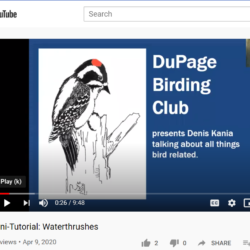More Recent News
DBC Shares Birding Tips in New Podcast
DBC President Steve Constantelos and Corresponding Secretary Joe Suchecki served as ambassadors for birding in a recent podcast for ParkTalk, a program of the Naperville Park District. Steve and Joe talked about great local birding sites and what birds observers might see, why they enjoy birding, the benefits of membership in the DuPage Birding Club and advice for beginners. Listen to the full podcast here: https://www.napervilleparks.org/podcast/s22-episode-02-bird-watching
Outreach Presentations Tee Up Spring
DBC members will be presenting three times in March at area community centers. To join the roster of presenters, contact Donna Kubik at dkubik@dupagebirding.org. Itasca Public Library, March 10 – Attracting Hummingbirds to Your Yard presented by Denis Kania. Woodridge Library, March 25 – Start Spring Birding! presented by John Cebula. Glenside Library, March 18 at 7:00pm – Spring Migration presented by Ron Skleney.
Mini-Tutorial: Leucistic Bird Plumage
The DBC Board is pleased to present Mini-Tutorials on the DBC YouTube Channel. What is that strange-looking bird in my yard? It could be a leucistic bird of a species you know quite well! This mini-tutorial covers leucistic bird plumage-a genetic mutation causing some feathers to appear white or frosted instead of their usual color. Sometimes all feathers are affected, but often it’s in a symmetrical, blotchy fashion. This fascinating rare phenomenon can affect all kinds of birds and makes for some tricky identifications. Get some practice reading ID clues with this video. The difference between leucistic and albino […]


